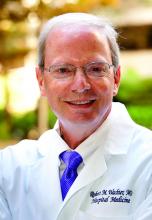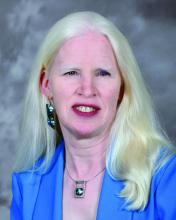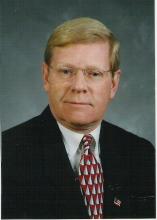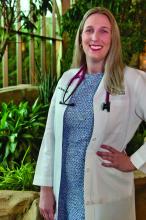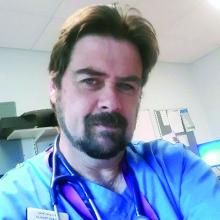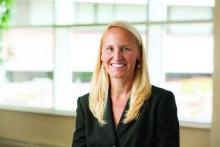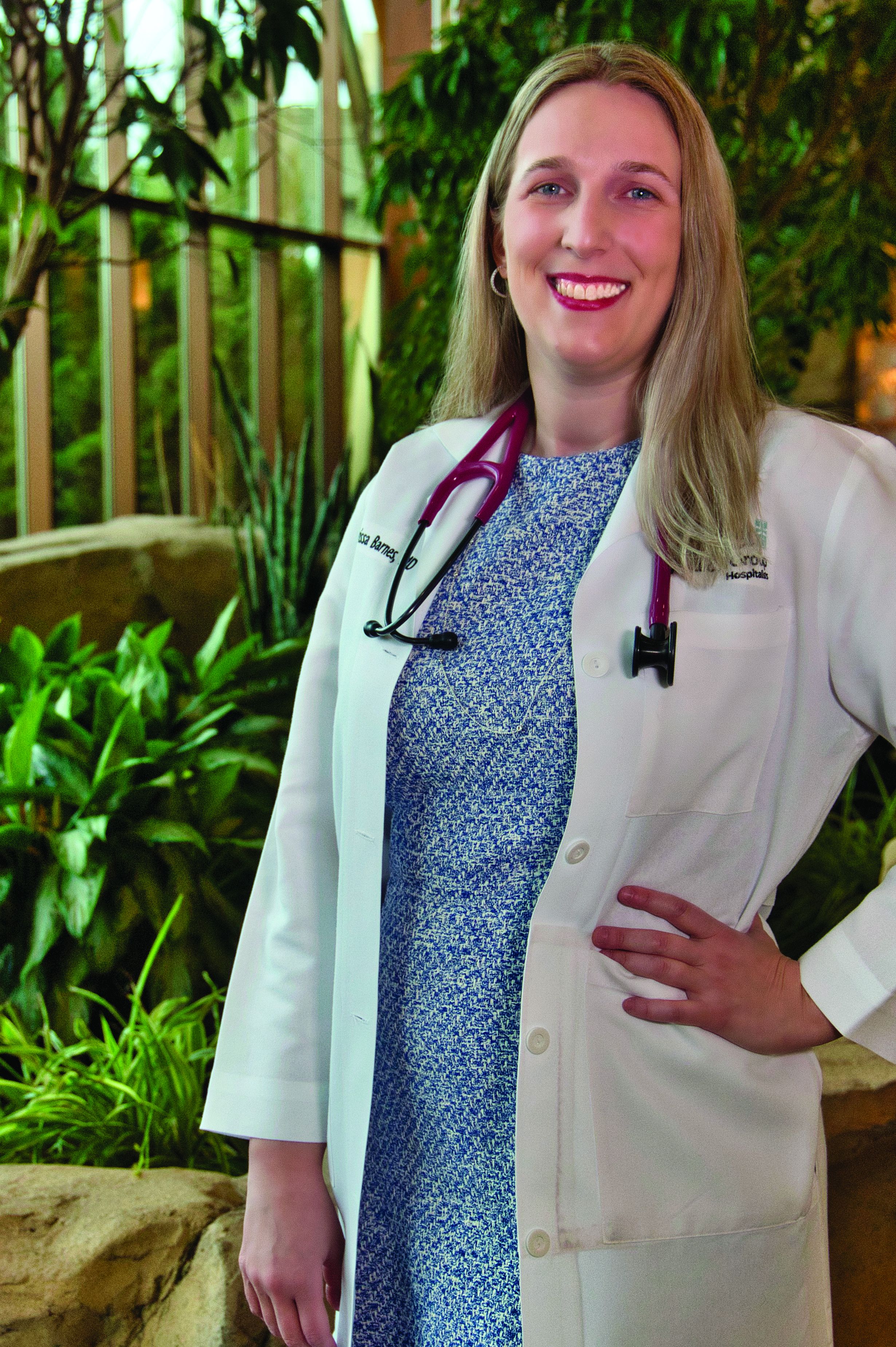User login
Focus on effort, not just outcomes
Moral distress can result when health professionals like doctors and nurses feel prevented from doing what they know is right and ethically correct – reflecting the values of their profession and their own sense of professional integrity – because of unmanageable caseload demands, lack of resources, coverage limitations, or institutional policies.
Hospitalists are not exempt from moral distress, which is associated with soul-searching, burnout, and even PTSD. It is also associated with a higher likelihood for professionals to report an intention to leave their jobs. But the COVID-19 pandemic has superimposed a whole new layer of challenges, constraints, and frustrations, creating a potent mix of trauma and exhaustion, cumulative unease, depleted job satisfaction, and difficult ethical choices.
These challenges include seeing so many patients die and working with short supplies of personal protective equipment (PPE) – with resulting fears that they could catch the virus or pass it on to others, including loved ones. Also, not having enough ventilators or even beds for patients in hospitals hit hard by COVID surges raises fears that decisions for rationing medical care might become necessary.
In a commentary published in the Journal of General Internal Medicine in October 2019 – shortly before the COVID pandemic burst onto the scene – hospitalist and medical sociologist Elizabeth Dzeng, MD, PhD, MPH, and hospital medicine pioneer Robert Wachter, MD, MHM, both from the University of California, San Francisco, described “moral distress and professional ethical dissonance as root causes of burnout.”1 They characterized moral distress by its emotional exhaustion, depersonalization, reduced sense of accomplishment, and moral apathy, and they called for renewed attention to social and ethical dimensions of practice and threats to physician professionalism.
Prevailing explanations for documented high rates of burnout in doctors have tended to focus on work hours and struggles with electronic medical records and the like, Dr. Dzeng and Dr. Wachter wrote. “We see evidence of an insidious moral distress resulting from physicians’ inability to act in accord with their individual and professional ethical values due to institutional and social constraints.”
COVID has intensified these issues surrounding moral distress. “In a short period of time it created more situations that raise issues of moral distress than I have seen since the early days of HIV,” Dr. Wachter said. “Those of us who work in hospitals often find ourselves in complex circumstances with limited resources. What was so striking about COVID was finding ourselves caring for large volumes of patients who had a condition that was new to us.”
And the fact that constraints imposed by COVID, such as having to don unwieldy PPE and not allowing families to be present with hospitalized loved ones, are explainable and rational only helps a little with the clinician’s distress.
People talk about the need for doctors to be more resilient, Dr. Dzeng added, but that’s too narrow of an approach to these very real challenges. There are huge issues of workforce retention and costs, major mental health issues, suicide – and implications for patient care, because burned-out doctors can be bad doctors.
What is moral distress?
Moral distress is a term from the nursing ethics literature, attributed to philosopher Andrew Jameton in 1984.2 Contributors to moral distress imposed by COVID include having to make difficult medical decisions under stressful circumstances – especially early on, when effective treatment options were few. Doctors felt the demands of the pandemic were putting care quality and patient safety at risk. Poor working conditions overall, being pushed to work beyond their normal physical limits for days at a time, and feelings of not being valued added to this stress. But some say the pandemic has only highlighted and amplified existing inequities and disparities in the health care system.
Experts say moral distress is about feeling powerless, especially in a system driven by market values, and feeling let down by a society that has put them in harm’s way. They work all day under physically and emotionally exhausting conditions and then go home to hear specious conspiracy theories about the pandemic and see other people unwilling to wear masks.
Moral distress is complicated, said Lucia Wocial, PhD, RN, a nurse ethicist and cochair of the ethics consultation subcommittee at Indiana University Health in Indianapolis. “If you say you have moral distress, my first response is: tell me more. It helps to peel back the layers of this complexity. Emotion is only part of moral distress. It’s about the professional’s sense of responsibility and obligation – and the inability to honor that.”
Dr. Wocial, whose research specialty is moral distress, is corresponding author of a study published in the Journal of General Internal Medicine in February 2020, which identified moral distress in 4 out of 10 surveyed physicians who cared for older hospitalized adults and found themselves needing to work with their surrogate decision-makers.3 “We know physician moral distress is higher when people haven’t had the chance to hold conversations about their end-of-life care preferences,” she said, such as whether to continue life support.
“We have also learned that communication is key to diminishing physician moral distress. Our responsibility as clinicians is to guide patients and families through these decisions. If the family feels a high level of support from me, then my moral distress is lower,” she added. “If you think about how COVID has evolved, at first people were dying so quickly. Some patients were going to the ICU on ventilators without ever having a goals-of-care conversation.”
COVID has shifted the usual standard of care in U.S. hospitals in the face of patient surges. “How can you feel okay in accepting a level of care that in the prepandemic world would not have been acceptable?” Dr. Wocial posed. “What if you know the standard of care has shifted, of necessity, but you haven’t had time to prepare for it and nobody’s talking about what that means? Who is going to help you accept that good enough under these circumstances is enough – at least for today?”
What to call it
Michael J. Asken, PhD, director of provider well-being at UPMC Pinnacle Harrisburg (Pa.), has questioned in print the use of the military and wartime term “moral injury” when applied to a variety of less serious physician stressors.4 More recently, however, he observed, “The pandemic has muted or erased many of the distinctions between medical care and military conflict. ... The onslaught and volume of critical patients and resulting deaths is beyond what most providers have ever contemplated as part of care.”5
In a recent interview with the Hospitalist, he said: “While I initially resisted using the term moral injury, especially pre-COVID, because it was not equivalent to the moral injury created by war, I have relented a bit.” The volume of deaths and the apparent dangers to providers themselves reflect some of the critical aspects of war, and repetitive, intense, and/or incessant ethical challenges may have longer term negative psychological or emotional effects.
“Feeling emotional pain in situations of multiple deaths is to be expected and, perhaps, should even be welcomed as a sign of retained humanity and a buffer against burnout and cynicism in these times of unabating stress,” Dr. Asken said. “This is only true, however, if the emotional impact is tolerable and not experienced in repetitive extremes.”
“These things are real,” said Clarissa Barnes, MD, a physician adviser, hospitalist at Avera McKennan Hospital in Sioux Falls, S.D., and former medical director of Avera’s LIGHT Program, a wellness-oriented service for clinicians. Dr. Barnes herself caught the virus on the job but has since recovered.
“Physicians don’t see their work as an occupation. It’s their core identity: I am a doctor; I practice medicine. If things are being done in ways I don’t think are right, that’s fundamentally a breach,” she said. “As internists, we have an opportunity to forestall death whenever we can and, if not, promote a peaceful death. That’s what made me choose this specialty. I think there’s value in allowing a person to end well. But when that doesn’t happen because of social or administrative reasons, that’s hard.”
Where is the leadership?
“A lot of moral injury comes down to the individual health system and its leaders. Some have done well; others you hear saying things that make you question whether these are the people you want leading the organization. Hospitalists need to have a clear value framework and an idea of how to negotiate things when decisions don’t match that framework,” Dr. Barnes said.
“Sometimes administrators have additional information that they’re not sharing,” she added. “They’re caught between a rock and a hard place regarding the decisions they have to make, but they need to be more transparent and not hold things so close to their vest while thinking they are helping clinicians [by doing so]. Physicians need to understand why they are being asked to do things counter to what they believe is appropriate.”
David Oliver, MD, a geriatrics and internal medicine consultant at Royal Berkshire Hospital in Reading, England, also practices as a hospital physician, a role similar to the hospitalist in the United States. “In any system, in any environment, the job of being a doctor, nurse, or other health professional carries a lot of responsibility. That is a timeless, inherent stress of medical practice. With COVID, we’ve seen a lot of emotional burdens – a whole separate set of problems outside of your control, where you are responsible for care but don’t have accountability,” he said.
“People like me, hospital doctors, are used to chronic workforce issues in the National Health Service. But we didn’t sign up to come and get COVID and be hospitalized ourselves.” More than 850 frontline health care providers in the U.K. have so far died from the virus, Dr. Oliver said. “I saw five patients die in 90 minutes one day in April. That’s above and beyond normal human capacity.”
In England specifically, he said, it has exposed underlying structural issues and serious workforce gaps, unfilled vacancies, and a much lower number of ICU beds per 100,000 population than the United States or Europe. And there is consistent pressure to send patients home in order to empty beds for new patients.
But a range of supportive services is offered in U.K. hospitals, such as making senior clinicians available to speak to frontline clinicians, providing mentorship and a sounding board. The Point of Care Foundation has helped to disseminate the practice of Schwartz Rounds, a group reflective practice forum for health care teams developed by the Schwartz Center for Compassionate Healthcare in Boston.
“We don’t need this clap-for-the-NHS heroes stuff,” Dr. Oliver said. “We need an adequate workforce and [better] working conditions. What happened on the front lines of the pandemic was heroic – all done by local clinical teams. But where was the government – the centralized NHS? A lot of frontline clinicians aren’t feeling valued, supported, or listened to.”
What can be done?
What are some things that hospitalists can do, individually and collectively, to try to prevent moral distress from turning into full-scale burnout? Dr. Wocial emphasized the importance of unit-based ethics conversations. “At IU Health we have someone who is available to sit down with frontline clinicians and help unpack what they are experiencing,” she said. Clinicians need to be able to process this terrible experience in order to sort out the feelings of sadness from questions of whether they are doing something wrong.
Hospital chaplains are exquisitely skilled at supporting people and debriefing hospital teams, Dr. Wocial added. Palliative care professionals are also skilled at facilitating goals of care conversations with patients and families and can support hospitalists through coaching and joint family meetings.
“It’s about raising your sense of agency in your job – what in your practice you can control. People need to be able to talk frankly about it. Some managers say to clinicians: ‘Just buck up,’ while others are doing a fabulous job of offering support to their staff,” Dr. Wocial said. Hospitalists have to be willing to say when they’ve had too much. “You may not get help when you first ask for it. Be persistent. Asking for help doesn’t make you weak.”
Most doctors have their own strategies for managing stress on the job, Dr. Wachter noted. “What makes it a little easier is not having to do it alone. Many find solace in community, but community has been constrained by this pandemic. You can’t just go out for a beer after work anymore. So what are other ways to let off steam?”
The people leading hospitalist programs need to work harder at creating community and empathy when the tools allowing people to get together are somewhat limited. “Everybody is tired of Zoom,” he said. “One thing I learned as a manager was to just send messages to people acknowledging that I know this is hard. Try to think from the lens of other people and what they would find useful.”
The pandemic has been terribly unpredictable, Dr. Wachter added, but it won’t go on forever. For some doctors, yoga or mindfulness meditation may be very comforting. “For me, that’s not what I do. Golf or a good Seinfeld episode works for me.”
SHM’s Wellbeing Taskforce has created a “Hospital Medicine COVID Check-in Guide for Self & Peers” to promote both sharing and support for one another. It can be found at SHM’s Wellbeing webpage [www.hospitalmedicine.org/practice-management/wellbeing/]. The Taskforce believes that sharing common stressors as hospitalists can be healing, said its chair, Sarah Richards, MD, assistant professor of medicine at the University of Nebraska, Omaha. “This is especially true in situations where we feel we can’t provide the type of care we know our patients deserve.”
Respect, advocacy, self-care
Dr. Asken encouraged clinicians to focus on the efforts they are making on the job, not just the outcomes. “If someone has done their absolute best in a given circumstance, satisfaction and solace needs to be taken from that,” he said.
“Ongoing support group meetings, which we have called frontline support groups, should occur on a regular basis. Designated for physicians on the medical floors and in critical care units who are directly involved with COVID patients, these provide a brief respite but also engagement, sharing, and strengthening of mutual support.”
A lot of these issues have a fundamental thread, which comes down to respect, Dr. Barnes said. “Hospitalists need to hear their hospital administrators say: ‘I hear what you’re saying [about a problem]. Let’s think together about how to solve it.’ We need to work on being clear, and we need to speak up for what’s right. If you aren’t comfortable doing things you are being asked to do in the hospital, maybe you’re not working in the right place.”
Some efforts in the area of wellness and self-care really are helpful, Dr. Barnes said. “But you can’t exercise you way through a health system that doesn’t respect you. You need to get out of the mindset that you have no ability to make things different. We are not powerless as doctors. We can do a lot, actually. Physicians need to take ownership. If you are a hospitalist and you’re not part of any local or state or national organization that advocates for physicians, you should be.”
References
1. Dzeng L and Wachter RM. Ethics in conflict: Moral distress as a root cause of burnout. J Gen Intern Med. 2020 Feb;35(2):409-11. doi: 10.1007/s11606-019-05505-6.
2. Jameton A, Nursing Practice: The ethical issues. Prentice Hall Series in the Philosophy of Medicine. 1984, Englewood Cliffs, N.J.: Prentice Hall.
3. Wocial LD et al. Factors associated with physician moral distress caring for hospitalized elderly patients needing a surrogate decision-maker: A prospective study. J Gen Intern Med. 2020 May;35(5):1405-12. doi: 10.1007/s11606-020-05652-1.
4. Asken MJ. It’s not moral injury: It’s burnout (or something else). Medical Economics; June 7, 2019.
5. Asken MJ. Now it is moral injury: The COVID-19 pandemic and moral distress. Medical Economics; April 29, 2020.
Focus on effort, not just outcomes
Focus on effort, not just outcomes
Moral distress can result when health professionals like doctors and nurses feel prevented from doing what they know is right and ethically correct – reflecting the values of their profession and their own sense of professional integrity – because of unmanageable caseload demands, lack of resources, coverage limitations, or institutional policies.
Hospitalists are not exempt from moral distress, which is associated with soul-searching, burnout, and even PTSD. It is also associated with a higher likelihood for professionals to report an intention to leave their jobs. But the COVID-19 pandemic has superimposed a whole new layer of challenges, constraints, and frustrations, creating a potent mix of trauma and exhaustion, cumulative unease, depleted job satisfaction, and difficult ethical choices.
These challenges include seeing so many patients die and working with short supplies of personal protective equipment (PPE) – with resulting fears that they could catch the virus or pass it on to others, including loved ones. Also, not having enough ventilators or even beds for patients in hospitals hit hard by COVID surges raises fears that decisions for rationing medical care might become necessary.
In a commentary published in the Journal of General Internal Medicine in October 2019 – shortly before the COVID pandemic burst onto the scene – hospitalist and medical sociologist Elizabeth Dzeng, MD, PhD, MPH, and hospital medicine pioneer Robert Wachter, MD, MHM, both from the University of California, San Francisco, described “moral distress and professional ethical dissonance as root causes of burnout.”1 They characterized moral distress by its emotional exhaustion, depersonalization, reduced sense of accomplishment, and moral apathy, and they called for renewed attention to social and ethical dimensions of practice and threats to physician professionalism.
Prevailing explanations for documented high rates of burnout in doctors have tended to focus on work hours and struggles with electronic medical records and the like, Dr. Dzeng and Dr. Wachter wrote. “We see evidence of an insidious moral distress resulting from physicians’ inability to act in accord with their individual and professional ethical values due to institutional and social constraints.”
COVID has intensified these issues surrounding moral distress. “In a short period of time it created more situations that raise issues of moral distress than I have seen since the early days of HIV,” Dr. Wachter said. “Those of us who work in hospitals often find ourselves in complex circumstances with limited resources. What was so striking about COVID was finding ourselves caring for large volumes of patients who had a condition that was new to us.”
And the fact that constraints imposed by COVID, such as having to don unwieldy PPE and not allowing families to be present with hospitalized loved ones, are explainable and rational only helps a little with the clinician’s distress.
People talk about the need for doctors to be more resilient, Dr. Dzeng added, but that’s too narrow of an approach to these very real challenges. There are huge issues of workforce retention and costs, major mental health issues, suicide – and implications for patient care, because burned-out doctors can be bad doctors.
What is moral distress?
Moral distress is a term from the nursing ethics literature, attributed to philosopher Andrew Jameton in 1984.2 Contributors to moral distress imposed by COVID include having to make difficult medical decisions under stressful circumstances – especially early on, when effective treatment options were few. Doctors felt the demands of the pandemic were putting care quality and patient safety at risk. Poor working conditions overall, being pushed to work beyond their normal physical limits for days at a time, and feelings of not being valued added to this stress. But some say the pandemic has only highlighted and amplified existing inequities and disparities in the health care system.
Experts say moral distress is about feeling powerless, especially in a system driven by market values, and feeling let down by a society that has put them in harm’s way. They work all day under physically and emotionally exhausting conditions and then go home to hear specious conspiracy theories about the pandemic and see other people unwilling to wear masks.
Moral distress is complicated, said Lucia Wocial, PhD, RN, a nurse ethicist and cochair of the ethics consultation subcommittee at Indiana University Health in Indianapolis. “If you say you have moral distress, my first response is: tell me more. It helps to peel back the layers of this complexity. Emotion is only part of moral distress. It’s about the professional’s sense of responsibility and obligation – and the inability to honor that.”
Dr. Wocial, whose research specialty is moral distress, is corresponding author of a study published in the Journal of General Internal Medicine in February 2020, which identified moral distress in 4 out of 10 surveyed physicians who cared for older hospitalized adults and found themselves needing to work with their surrogate decision-makers.3 “We know physician moral distress is higher when people haven’t had the chance to hold conversations about their end-of-life care preferences,” she said, such as whether to continue life support.
“We have also learned that communication is key to diminishing physician moral distress. Our responsibility as clinicians is to guide patients and families through these decisions. If the family feels a high level of support from me, then my moral distress is lower,” she added. “If you think about how COVID has evolved, at first people were dying so quickly. Some patients were going to the ICU on ventilators without ever having a goals-of-care conversation.”
COVID has shifted the usual standard of care in U.S. hospitals in the face of patient surges. “How can you feel okay in accepting a level of care that in the prepandemic world would not have been acceptable?” Dr. Wocial posed. “What if you know the standard of care has shifted, of necessity, but you haven’t had time to prepare for it and nobody’s talking about what that means? Who is going to help you accept that good enough under these circumstances is enough – at least for today?”
What to call it
Michael J. Asken, PhD, director of provider well-being at UPMC Pinnacle Harrisburg (Pa.), has questioned in print the use of the military and wartime term “moral injury” when applied to a variety of less serious physician stressors.4 More recently, however, he observed, “The pandemic has muted or erased many of the distinctions between medical care and military conflict. ... The onslaught and volume of critical patients and resulting deaths is beyond what most providers have ever contemplated as part of care.”5
In a recent interview with the Hospitalist, he said: “While I initially resisted using the term moral injury, especially pre-COVID, because it was not equivalent to the moral injury created by war, I have relented a bit.” The volume of deaths and the apparent dangers to providers themselves reflect some of the critical aspects of war, and repetitive, intense, and/or incessant ethical challenges may have longer term negative psychological or emotional effects.
“Feeling emotional pain in situations of multiple deaths is to be expected and, perhaps, should even be welcomed as a sign of retained humanity and a buffer against burnout and cynicism in these times of unabating stress,” Dr. Asken said. “This is only true, however, if the emotional impact is tolerable and not experienced in repetitive extremes.”
“These things are real,” said Clarissa Barnes, MD, a physician adviser, hospitalist at Avera McKennan Hospital in Sioux Falls, S.D., and former medical director of Avera’s LIGHT Program, a wellness-oriented service for clinicians. Dr. Barnes herself caught the virus on the job but has since recovered.
“Physicians don’t see their work as an occupation. It’s their core identity: I am a doctor; I practice medicine. If things are being done in ways I don’t think are right, that’s fundamentally a breach,” she said. “As internists, we have an opportunity to forestall death whenever we can and, if not, promote a peaceful death. That’s what made me choose this specialty. I think there’s value in allowing a person to end well. But when that doesn’t happen because of social or administrative reasons, that’s hard.”
Where is the leadership?
“A lot of moral injury comes down to the individual health system and its leaders. Some have done well; others you hear saying things that make you question whether these are the people you want leading the organization. Hospitalists need to have a clear value framework and an idea of how to negotiate things when decisions don’t match that framework,” Dr. Barnes said.
“Sometimes administrators have additional information that they’re not sharing,” she added. “They’re caught between a rock and a hard place regarding the decisions they have to make, but they need to be more transparent and not hold things so close to their vest while thinking they are helping clinicians [by doing so]. Physicians need to understand why they are being asked to do things counter to what they believe is appropriate.”
David Oliver, MD, a geriatrics and internal medicine consultant at Royal Berkshire Hospital in Reading, England, also practices as a hospital physician, a role similar to the hospitalist in the United States. “In any system, in any environment, the job of being a doctor, nurse, or other health professional carries a lot of responsibility. That is a timeless, inherent stress of medical practice. With COVID, we’ve seen a lot of emotional burdens – a whole separate set of problems outside of your control, where you are responsible for care but don’t have accountability,” he said.
“People like me, hospital doctors, are used to chronic workforce issues in the National Health Service. But we didn’t sign up to come and get COVID and be hospitalized ourselves.” More than 850 frontline health care providers in the U.K. have so far died from the virus, Dr. Oliver said. “I saw five patients die in 90 minutes one day in April. That’s above and beyond normal human capacity.”
In England specifically, he said, it has exposed underlying structural issues and serious workforce gaps, unfilled vacancies, and a much lower number of ICU beds per 100,000 population than the United States or Europe. And there is consistent pressure to send patients home in order to empty beds for new patients.
But a range of supportive services is offered in U.K. hospitals, such as making senior clinicians available to speak to frontline clinicians, providing mentorship and a sounding board. The Point of Care Foundation has helped to disseminate the practice of Schwartz Rounds, a group reflective practice forum for health care teams developed by the Schwartz Center for Compassionate Healthcare in Boston.
“We don’t need this clap-for-the-NHS heroes stuff,” Dr. Oliver said. “We need an adequate workforce and [better] working conditions. What happened on the front lines of the pandemic was heroic – all done by local clinical teams. But where was the government – the centralized NHS? A lot of frontline clinicians aren’t feeling valued, supported, or listened to.”
What can be done?
What are some things that hospitalists can do, individually and collectively, to try to prevent moral distress from turning into full-scale burnout? Dr. Wocial emphasized the importance of unit-based ethics conversations. “At IU Health we have someone who is available to sit down with frontline clinicians and help unpack what they are experiencing,” she said. Clinicians need to be able to process this terrible experience in order to sort out the feelings of sadness from questions of whether they are doing something wrong.
Hospital chaplains are exquisitely skilled at supporting people and debriefing hospital teams, Dr. Wocial added. Palliative care professionals are also skilled at facilitating goals of care conversations with patients and families and can support hospitalists through coaching and joint family meetings.
“It’s about raising your sense of agency in your job – what in your practice you can control. People need to be able to talk frankly about it. Some managers say to clinicians: ‘Just buck up,’ while others are doing a fabulous job of offering support to their staff,” Dr. Wocial said. Hospitalists have to be willing to say when they’ve had too much. “You may not get help when you first ask for it. Be persistent. Asking for help doesn’t make you weak.”
Most doctors have their own strategies for managing stress on the job, Dr. Wachter noted. “What makes it a little easier is not having to do it alone. Many find solace in community, but community has been constrained by this pandemic. You can’t just go out for a beer after work anymore. So what are other ways to let off steam?”
The people leading hospitalist programs need to work harder at creating community and empathy when the tools allowing people to get together are somewhat limited. “Everybody is tired of Zoom,” he said. “One thing I learned as a manager was to just send messages to people acknowledging that I know this is hard. Try to think from the lens of other people and what they would find useful.”
The pandemic has been terribly unpredictable, Dr. Wachter added, but it won’t go on forever. For some doctors, yoga or mindfulness meditation may be very comforting. “For me, that’s not what I do. Golf or a good Seinfeld episode works for me.”
SHM’s Wellbeing Taskforce has created a “Hospital Medicine COVID Check-in Guide for Self & Peers” to promote both sharing and support for one another. It can be found at SHM’s Wellbeing webpage [www.hospitalmedicine.org/practice-management/wellbeing/]. The Taskforce believes that sharing common stressors as hospitalists can be healing, said its chair, Sarah Richards, MD, assistant professor of medicine at the University of Nebraska, Omaha. “This is especially true in situations where we feel we can’t provide the type of care we know our patients deserve.”
Respect, advocacy, self-care
Dr. Asken encouraged clinicians to focus on the efforts they are making on the job, not just the outcomes. “If someone has done their absolute best in a given circumstance, satisfaction and solace needs to be taken from that,” he said.
“Ongoing support group meetings, which we have called frontline support groups, should occur on a regular basis. Designated for physicians on the medical floors and in critical care units who are directly involved with COVID patients, these provide a brief respite but also engagement, sharing, and strengthening of mutual support.”
A lot of these issues have a fundamental thread, which comes down to respect, Dr. Barnes said. “Hospitalists need to hear their hospital administrators say: ‘I hear what you’re saying [about a problem]. Let’s think together about how to solve it.’ We need to work on being clear, and we need to speak up for what’s right. If you aren’t comfortable doing things you are being asked to do in the hospital, maybe you’re not working in the right place.”
Some efforts in the area of wellness and self-care really are helpful, Dr. Barnes said. “But you can’t exercise you way through a health system that doesn’t respect you. You need to get out of the mindset that you have no ability to make things different. We are not powerless as doctors. We can do a lot, actually. Physicians need to take ownership. If you are a hospitalist and you’re not part of any local or state or national organization that advocates for physicians, you should be.”
References
1. Dzeng L and Wachter RM. Ethics in conflict: Moral distress as a root cause of burnout. J Gen Intern Med. 2020 Feb;35(2):409-11. doi: 10.1007/s11606-019-05505-6.
2. Jameton A, Nursing Practice: The ethical issues. Prentice Hall Series in the Philosophy of Medicine. 1984, Englewood Cliffs, N.J.: Prentice Hall.
3. Wocial LD et al. Factors associated with physician moral distress caring for hospitalized elderly patients needing a surrogate decision-maker: A prospective study. J Gen Intern Med. 2020 May;35(5):1405-12. doi: 10.1007/s11606-020-05652-1.
4. Asken MJ. It’s not moral injury: It’s burnout (or something else). Medical Economics; June 7, 2019.
5. Asken MJ. Now it is moral injury: The COVID-19 pandemic and moral distress. Medical Economics; April 29, 2020.
Moral distress can result when health professionals like doctors and nurses feel prevented from doing what they know is right and ethically correct – reflecting the values of their profession and their own sense of professional integrity – because of unmanageable caseload demands, lack of resources, coverage limitations, or institutional policies.
Hospitalists are not exempt from moral distress, which is associated with soul-searching, burnout, and even PTSD. It is also associated with a higher likelihood for professionals to report an intention to leave their jobs. But the COVID-19 pandemic has superimposed a whole new layer of challenges, constraints, and frustrations, creating a potent mix of trauma and exhaustion, cumulative unease, depleted job satisfaction, and difficult ethical choices.
These challenges include seeing so many patients die and working with short supplies of personal protective equipment (PPE) – with resulting fears that they could catch the virus or pass it on to others, including loved ones. Also, not having enough ventilators or even beds for patients in hospitals hit hard by COVID surges raises fears that decisions for rationing medical care might become necessary.
In a commentary published in the Journal of General Internal Medicine in October 2019 – shortly before the COVID pandemic burst onto the scene – hospitalist and medical sociologist Elizabeth Dzeng, MD, PhD, MPH, and hospital medicine pioneer Robert Wachter, MD, MHM, both from the University of California, San Francisco, described “moral distress and professional ethical dissonance as root causes of burnout.”1 They characterized moral distress by its emotional exhaustion, depersonalization, reduced sense of accomplishment, and moral apathy, and they called for renewed attention to social and ethical dimensions of practice and threats to physician professionalism.
Prevailing explanations for documented high rates of burnout in doctors have tended to focus on work hours and struggles with electronic medical records and the like, Dr. Dzeng and Dr. Wachter wrote. “We see evidence of an insidious moral distress resulting from physicians’ inability to act in accord with their individual and professional ethical values due to institutional and social constraints.”
COVID has intensified these issues surrounding moral distress. “In a short period of time it created more situations that raise issues of moral distress than I have seen since the early days of HIV,” Dr. Wachter said. “Those of us who work in hospitals often find ourselves in complex circumstances with limited resources. What was so striking about COVID was finding ourselves caring for large volumes of patients who had a condition that was new to us.”
And the fact that constraints imposed by COVID, such as having to don unwieldy PPE and not allowing families to be present with hospitalized loved ones, are explainable and rational only helps a little with the clinician’s distress.
People talk about the need for doctors to be more resilient, Dr. Dzeng added, but that’s too narrow of an approach to these very real challenges. There are huge issues of workforce retention and costs, major mental health issues, suicide – and implications for patient care, because burned-out doctors can be bad doctors.
What is moral distress?
Moral distress is a term from the nursing ethics literature, attributed to philosopher Andrew Jameton in 1984.2 Contributors to moral distress imposed by COVID include having to make difficult medical decisions under stressful circumstances – especially early on, when effective treatment options were few. Doctors felt the demands of the pandemic were putting care quality and patient safety at risk. Poor working conditions overall, being pushed to work beyond their normal physical limits for days at a time, and feelings of not being valued added to this stress. But some say the pandemic has only highlighted and amplified existing inequities and disparities in the health care system.
Experts say moral distress is about feeling powerless, especially in a system driven by market values, and feeling let down by a society that has put them in harm’s way. They work all day under physically and emotionally exhausting conditions and then go home to hear specious conspiracy theories about the pandemic and see other people unwilling to wear masks.
Moral distress is complicated, said Lucia Wocial, PhD, RN, a nurse ethicist and cochair of the ethics consultation subcommittee at Indiana University Health in Indianapolis. “If you say you have moral distress, my first response is: tell me more. It helps to peel back the layers of this complexity. Emotion is only part of moral distress. It’s about the professional’s sense of responsibility and obligation – and the inability to honor that.”
Dr. Wocial, whose research specialty is moral distress, is corresponding author of a study published in the Journal of General Internal Medicine in February 2020, which identified moral distress in 4 out of 10 surveyed physicians who cared for older hospitalized adults and found themselves needing to work with their surrogate decision-makers.3 “We know physician moral distress is higher when people haven’t had the chance to hold conversations about their end-of-life care preferences,” she said, such as whether to continue life support.
“We have also learned that communication is key to diminishing physician moral distress. Our responsibility as clinicians is to guide patients and families through these decisions. If the family feels a high level of support from me, then my moral distress is lower,” she added. “If you think about how COVID has evolved, at first people were dying so quickly. Some patients were going to the ICU on ventilators without ever having a goals-of-care conversation.”
COVID has shifted the usual standard of care in U.S. hospitals in the face of patient surges. “How can you feel okay in accepting a level of care that in the prepandemic world would not have been acceptable?” Dr. Wocial posed. “What if you know the standard of care has shifted, of necessity, but you haven’t had time to prepare for it and nobody’s talking about what that means? Who is going to help you accept that good enough under these circumstances is enough – at least for today?”
What to call it
Michael J. Asken, PhD, director of provider well-being at UPMC Pinnacle Harrisburg (Pa.), has questioned in print the use of the military and wartime term “moral injury” when applied to a variety of less serious physician stressors.4 More recently, however, he observed, “The pandemic has muted or erased many of the distinctions between medical care and military conflict. ... The onslaught and volume of critical patients and resulting deaths is beyond what most providers have ever contemplated as part of care.”5
In a recent interview with the Hospitalist, he said: “While I initially resisted using the term moral injury, especially pre-COVID, because it was not equivalent to the moral injury created by war, I have relented a bit.” The volume of deaths and the apparent dangers to providers themselves reflect some of the critical aspects of war, and repetitive, intense, and/or incessant ethical challenges may have longer term negative psychological or emotional effects.
“Feeling emotional pain in situations of multiple deaths is to be expected and, perhaps, should even be welcomed as a sign of retained humanity and a buffer against burnout and cynicism in these times of unabating stress,” Dr. Asken said. “This is only true, however, if the emotional impact is tolerable and not experienced in repetitive extremes.”
“These things are real,” said Clarissa Barnes, MD, a physician adviser, hospitalist at Avera McKennan Hospital in Sioux Falls, S.D., and former medical director of Avera’s LIGHT Program, a wellness-oriented service for clinicians. Dr. Barnes herself caught the virus on the job but has since recovered.
“Physicians don’t see their work as an occupation. It’s their core identity: I am a doctor; I practice medicine. If things are being done in ways I don’t think are right, that’s fundamentally a breach,” she said. “As internists, we have an opportunity to forestall death whenever we can and, if not, promote a peaceful death. That’s what made me choose this specialty. I think there’s value in allowing a person to end well. But when that doesn’t happen because of social or administrative reasons, that’s hard.”
Where is the leadership?
“A lot of moral injury comes down to the individual health system and its leaders. Some have done well; others you hear saying things that make you question whether these are the people you want leading the organization. Hospitalists need to have a clear value framework and an idea of how to negotiate things when decisions don’t match that framework,” Dr. Barnes said.
“Sometimes administrators have additional information that they’re not sharing,” she added. “They’re caught between a rock and a hard place regarding the decisions they have to make, but they need to be more transparent and not hold things so close to their vest while thinking they are helping clinicians [by doing so]. Physicians need to understand why they are being asked to do things counter to what they believe is appropriate.”
David Oliver, MD, a geriatrics and internal medicine consultant at Royal Berkshire Hospital in Reading, England, also practices as a hospital physician, a role similar to the hospitalist in the United States. “In any system, in any environment, the job of being a doctor, nurse, or other health professional carries a lot of responsibility. That is a timeless, inherent stress of medical practice. With COVID, we’ve seen a lot of emotional burdens – a whole separate set of problems outside of your control, where you are responsible for care but don’t have accountability,” he said.
“People like me, hospital doctors, are used to chronic workforce issues in the National Health Service. But we didn’t sign up to come and get COVID and be hospitalized ourselves.” More than 850 frontline health care providers in the U.K. have so far died from the virus, Dr. Oliver said. “I saw five patients die in 90 minutes one day in April. That’s above and beyond normal human capacity.”
In England specifically, he said, it has exposed underlying structural issues and serious workforce gaps, unfilled vacancies, and a much lower number of ICU beds per 100,000 population than the United States or Europe. And there is consistent pressure to send patients home in order to empty beds for new patients.
But a range of supportive services is offered in U.K. hospitals, such as making senior clinicians available to speak to frontline clinicians, providing mentorship and a sounding board. The Point of Care Foundation has helped to disseminate the practice of Schwartz Rounds, a group reflective practice forum for health care teams developed by the Schwartz Center for Compassionate Healthcare in Boston.
“We don’t need this clap-for-the-NHS heroes stuff,” Dr. Oliver said. “We need an adequate workforce and [better] working conditions. What happened on the front lines of the pandemic was heroic – all done by local clinical teams. But where was the government – the centralized NHS? A lot of frontline clinicians aren’t feeling valued, supported, or listened to.”
What can be done?
What are some things that hospitalists can do, individually and collectively, to try to prevent moral distress from turning into full-scale burnout? Dr. Wocial emphasized the importance of unit-based ethics conversations. “At IU Health we have someone who is available to sit down with frontline clinicians and help unpack what they are experiencing,” she said. Clinicians need to be able to process this terrible experience in order to sort out the feelings of sadness from questions of whether they are doing something wrong.
Hospital chaplains are exquisitely skilled at supporting people and debriefing hospital teams, Dr. Wocial added. Palliative care professionals are also skilled at facilitating goals of care conversations with patients and families and can support hospitalists through coaching and joint family meetings.
“It’s about raising your sense of agency in your job – what in your practice you can control. People need to be able to talk frankly about it. Some managers say to clinicians: ‘Just buck up,’ while others are doing a fabulous job of offering support to their staff,” Dr. Wocial said. Hospitalists have to be willing to say when they’ve had too much. “You may not get help when you first ask for it. Be persistent. Asking for help doesn’t make you weak.”
Most doctors have their own strategies for managing stress on the job, Dr. Wachter noted. “What makes it a little easier is not having to do it alone. Many find solace in community, but community has been constrained by this pandemic. You can’t just go out for a beer after work anymore. So what are other ways to let off steam?”
The people leading hospitalist programs need to work harder at creating community and empathy when the tools allowing people to get together are somewhat limited. “Everybody is tired of Zoom,” he said. “One thing I learned as a manager was to just send messages to people acknowledging that I know this is hard. Try to think from the lens of other people and what they would find useful.”
The pandemic has been terribly unpredictable, Dr. Wachter added, but it won’t go on forever. For some doctors, yoga or mindfulness meditation may be very comforting. “For me, that’s not what I do. Golf or a good Seinfeld episode works for me.”
SHM’s Wellbeing Taskforce has created a “Hospital Medicine COVID Check-in Guide for Self & Peers” to promote both sharing and support for one another. It can be found at SHM’s Wellbeing webpage [www.hospitalmedicine.org/practice-management/wellbeing/]. The Taskforce believes that sharing common stressors as hospitalists can be healing, said its chair, Sarah Richards, MD, assistant professor of medicine at the University of Nebraska, Omaha. “This is especially true in situations where we feel we can’t provide the type of care we know our patients deserve.”
Respect, advocacy, self-care
Dr. Asken encouraged clinicians to focus on the efforts they are making on the job, not just the outcomes. “If someone has done their absolute best in a given circumstance, satisfaction and solace needs to be taken from that,” he said.
“Ongoing support group meetings, which we have called frontline support groups, should occur on a regular basis. Designated for physicians on the medical floors and in critical care units who are directly involved with COVID patients, these provide a brief respite but also engagement, sharing, and strengthening of mutual support.”
A lot of these issues have a fundamental thread, which comes down to respect, Dr. Barnes said. “Hospitalists need to hear their hospital administrators say: ‘I hear what you’re saying [about a problem]. Let’s think together about how to solve it.’ We need to work on being clear, and we need to speak up for what’s right. If you aren’t comfortable doing things you are being asked to do in the hospital, maybe you’re not working in the right place.”
Some efforts in the area of wellness and self-care really are helpful, Dr. Barnes said. “But you can’t exercise you way through a health system that doesn’t respect you. You need to get out of the mindset that you have no ability to make things different. We are not powerless as doctors. We can do a lot, actually. Physicians need to take ownership. If you are a hospitalist and you’re not part of any local or state or national organization that advocates for physicians, you should be.”
References
1. Dzeng L and Wachter RM. Ethics in conflict: Moral distress as a root cause of burnout. J Gen Intern Med. 2020 Feb;35(2):409-11. doi: 10.1007/s11606-019-05505-6.
2. Jameton A, Nursing Practice: The ethical issues. Prentice Hall Series in the Philosophy of Medicine. 1984, Englewood Cliffs, N.J.: Prentice Hall.
3. Wocial LD et al. Factors associated with physician moral distress caring for hospitalized elderly patients needing a surrogate decision-maker: A prospective study. J Gen Intern Med. 2020 May;35(5):1405-12. doi: 10.1007/s11606-020-05652-1.
4. Asken MJ. It’s not moral injury: It’s burnout (or something else). Medical Economics; June 7, 2019.
5. Asken MJ. Now it is moral injury: The COVID-19 pandemic and moral distress. Medical Economics; April 29, 2020.

